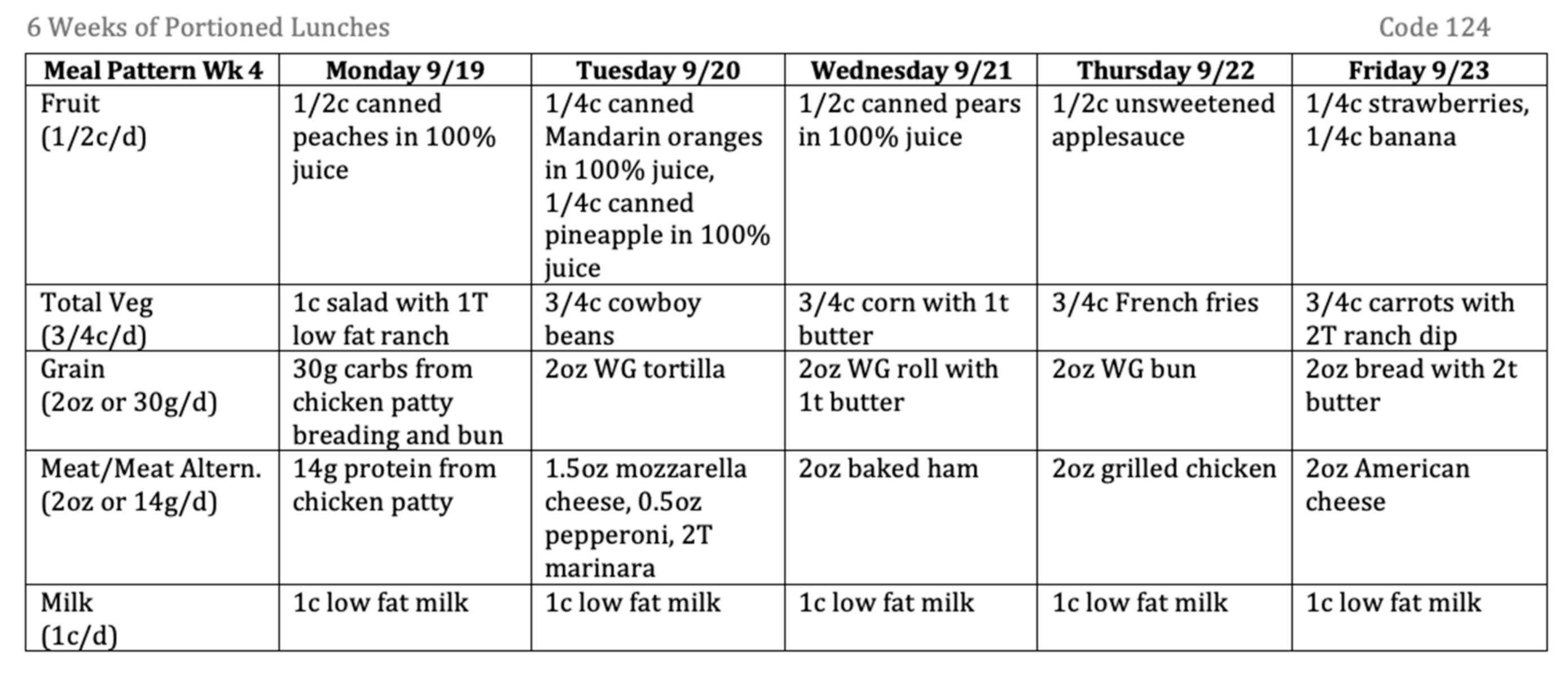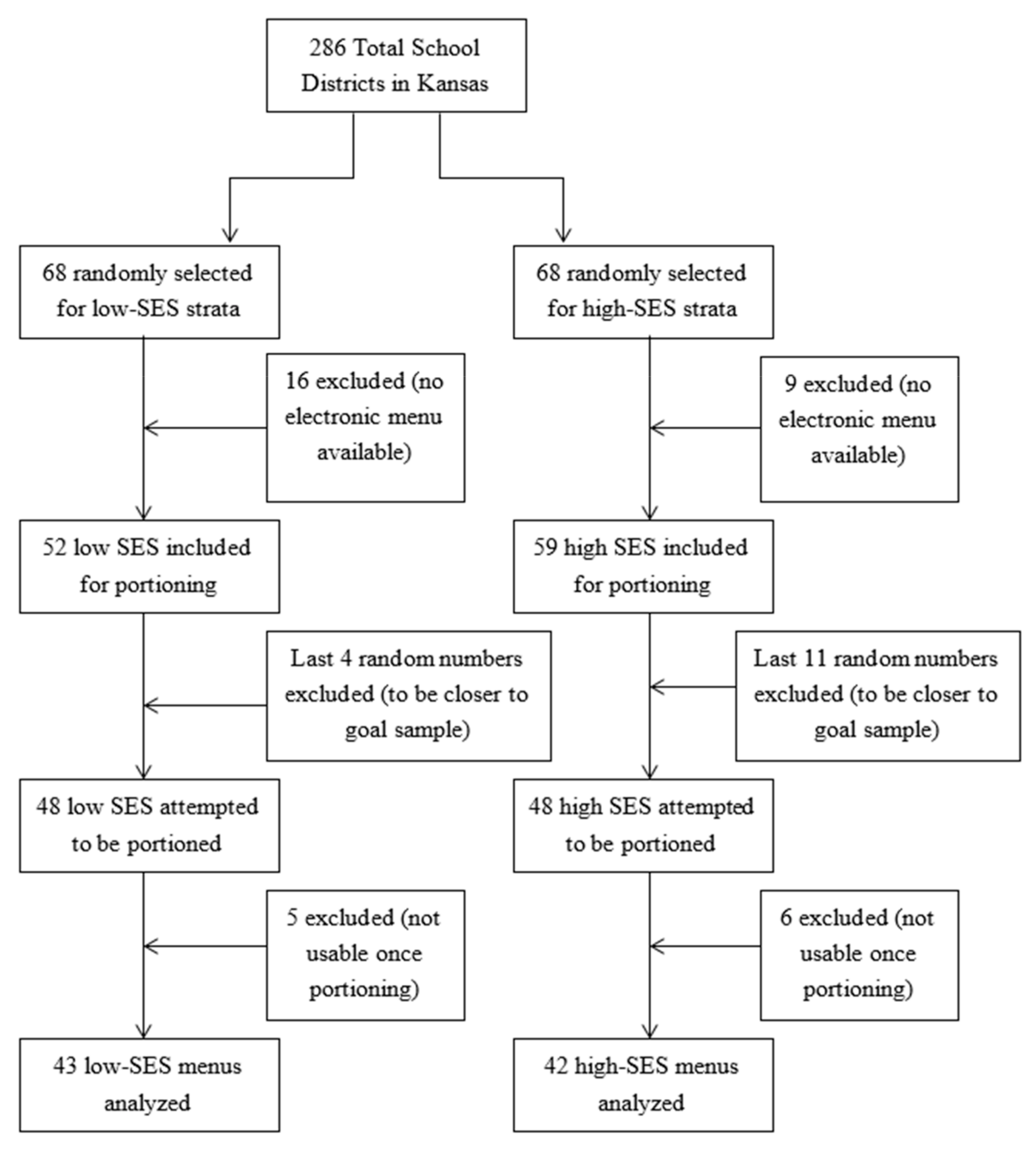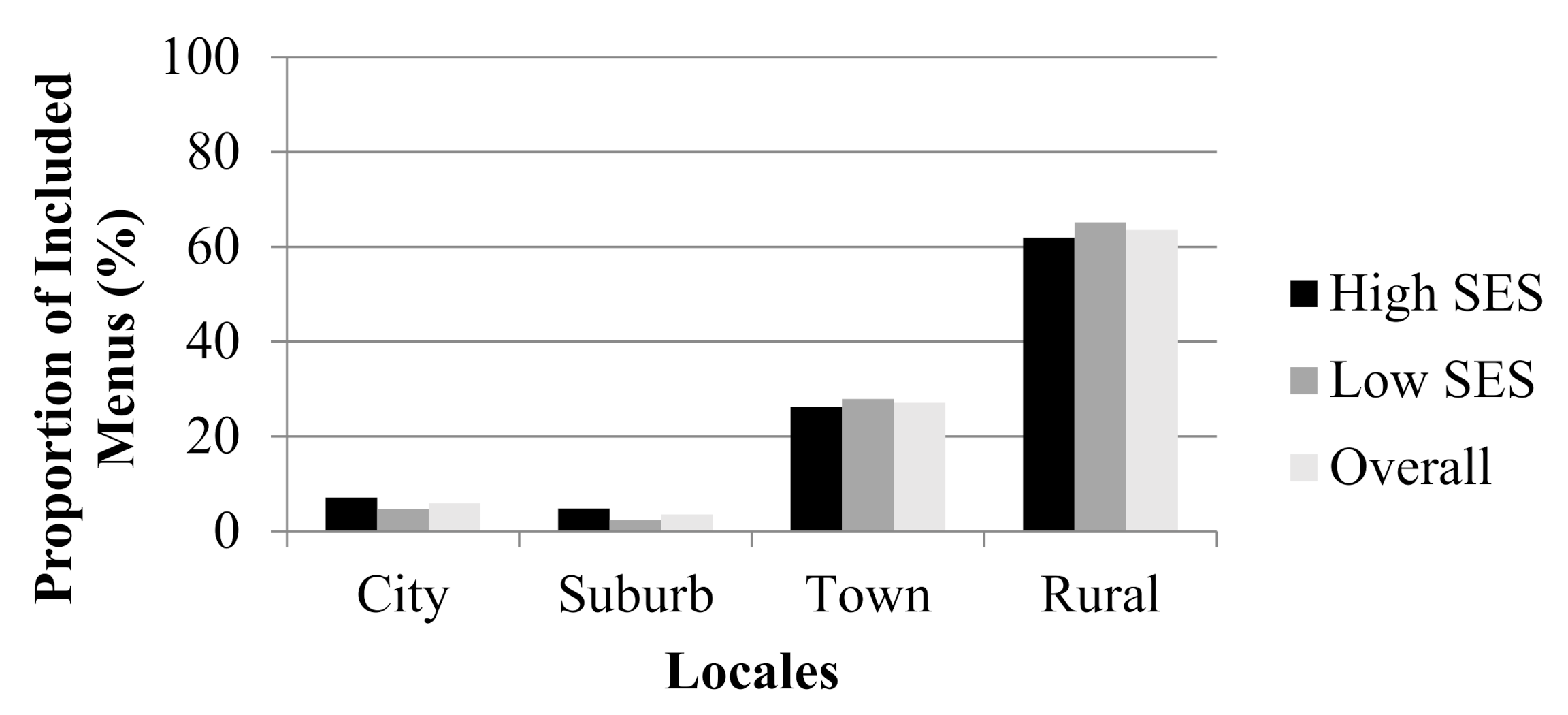Evaluation of Variability in Dietary Quality of School Lunches Meeting National School Lunch Program Guidelines by Socioeconomic Status and Rurality
Abstract
1. Introduction
2. Materials and Methods
2.1. Socioeconomic Status
2.2. Rurality
2.3. Sample
2.4. Nutrient Content
2.5. Dietary Quality
2.6. Statistical Analysis
3. Results
4. Discussion
5. Conclusions
Supplementary Materials
Author Contributions
Funding
Acknowledgments
Conflicts of Interest
References
- Nutrition and Public Health, USDA Food and Nutrition Service. Available online: https://www.fns.usda.gov/nutrition-and-public-health (accessed on 30 May 2018).
- Federal Food Assistance Resources, USDA Food and Nutrition Service. Available online: https://fns-prod.azureedge.net/sites/default/files/getinvolved/Federal-Food-Assistance-Resources.pdf (accessed on 30 May 2018).
- National School Lunch Program, USDA Food and Nutrition Service. Available online: https://www.fns.usda.gov/nslp/national-school-lunch-program-nslp (accessed on 30 May 2018).
- Joyce, J.; Rosenkranz, R.R.; Rosenkranz, S.K. Variation in nutritional quality of school lunches with implementation of national school lunch program guidelines. J. Sch. Health 2018, 88, 636–643. [Google Scholar] [CrossRef] [PubMed]
- Patel, K.J.; Strait, K.M.; Hildebrand, D.A.; Amaya, L.L.; Joyce, J.M. Variability in dietary quality of elementary school lunch menus with changes in national school lunch program nutrition standards. Curr. Dev. Nutr. 2020, 4, nzaa138. [Google Scholar] [CrossRef] [PubMed]
- Nollen, N.L.; Befort, C.A.; Snow, T.S.; Daley, C.M.; Ellerbeck, E.F.; Ahluwalia, J.S. The school food environment and adolescent obesity: Qualitative insights from high school principals and food service personnel. Int. J. Behav. Nutr. Phys. Act. 2007, 4, 1–12. [Google Scholar] [CrossRef] [PubMed][Green Version]
- Brouse, C.H.; Wolf, R.L.; Basch, C.E. School food service directors’ perceptions of barriers to and strategies for improving the school food environment in the United States. Int. J. Health Promot. Educ. 2009, 47, 88–93. [Google Scholar] [CrossRef]
- Fulkerson, J.A.; French, S.A.; Story, M.; Snyder, P.; Paddock, M. Foodservice staff perceptions of their influence on student food choices. J. Am. Diet. Assoc. 2002, 102, 97–99. [Google Scholar] [CrossRef]
- Hanson, M.D.; Chen, E. Socioeconomic status and health behaviors in adolescence: A review of the literature. J. Behav. Med. 2007, 30, 263–285. [Google Scholar] [CrossRef] [PubMed]
- Fahlman, M.M.; McCaughtry, N.; Martin, J.J.; Shen, B. Racial and socioeconomic disparities in nutrition behaviors: Targeted interventions needed. J. Nutr. Educ. Behav. 2010, 42, 10–16. [Google Scholar] [CrossRef] [PubMed]
- Delva, J.; O’Malley, P.M.; Johnston, L.D. Availability of more-healthy and less-healthy food choices in American schools: A national study by grade, racial/ ethnic, and socioeconomic differences. Am. J. Prev. Med. 2007, 33, S226–S239. [Google Scholar] [CrossRef] [PubMed]
- Davis, A.M.; Bennett, K.J.; Befort, C.; Nollen, N. Obesity and Related Health Behaviors Among Urban and Rural Children in the United States: Data from the National Health and Nutrition Examination Survey 2003–2004 and 2005–2006. J. Pediatr. Psychol. 2011, 36, 669–676. [Google Scholar] [CrossRef] [PubMed]
- Befort, C.A.; Nazir, N.; Perri, M.G. Prevalence of obesity among adults from rural and urban areas of the United States: Findings from NHANES (2005–2008). J. Rural. Health 2012, 28, 392–397. [Google Scholar] [CrossRef] [PubMed]
- Eberhardt, M.S.; Pamuk, E.R. The importance of place of residence: Examining health in rural and nonrural areas. Am. J. Public Health 2004, 94, 1682–1686. [Google Scholar] [CrossRef] [PubMed]
- Parks, S.E.; Housemann, R.A.; Brownson, R.C. Differential correlates of physical activity in urban and rural adults of various socioeconomic backgrounds in the United States. J. Epidemiol. Community Health 2003, 57, 29–35. [Google Scholar] [CrossRef] [PubMed]
- Tia-Seale, T.; Chandler, C. Nutrition and overweight concerns in rural areas: A literature review. In Rural Healthy People 2010: A Companion Document to Healthy People 2010; The Texas A & M University System Health Science Center, School of Rural Public Health, Southwest Rural Health Research Center: College Station, TX, USA, 2010; Volume 3. [Google Scholar]
- Kansas K-12 Report Generator, Kansas Department of Education Data Central. Available online: http://datacentral.ksde.org/report_gen.aspx (accessed on 23 August 2016).
- Search for Public School Districts, National Center for Education Statistics. Available online: https://nces.ed.gov/ccd/districtsearch/ (accessed on 31 May 2018).
- Urban Education in America, National Center for Education Statistics. Available online: https://nces.ed.gov/surveys/urbaned/priorclassification.asp (accessed on 31 May 2018).
- Final Rule Nutrition Standards in the National School Lunch and Breakfast Programs, USDA Food and Nutrition Service. Available online: https://fns-prod.azureedge.net/sites/default/files/dietaryspecs.pdf (accessed on 28 May 2018).
- Comparing the HEI-2015, HEI-2010 & HEI-2005, National Cancer Institute: Division of Cancer Control & Population Sciences. Available online: https://epi.grants.cancer.gov/hei/comparing.html (accessed on 5 June 2018).
- Reedy, J.; Lerman, J.L.; Krebs-Smith, S.M.; Kirkpatrick, S.I.; Pannucci, T.E.; Wilson, M.M.; Subar, A.F.; Kahle, L.L.; Tooze, J.A. Evaluation of the healthy eating index-2015. J. Acad. Nutr. Diet. 2018, 118, 1622–1633. [Google Scholar] [CrossRef] [PubMed]
- Hiza, H.; Guenther, P.M.; Rihane, C.I. Diet quality of children age 2–17 years as measured by the Healthy Eating Index-2010. Nutr. Insight 2013, 52, 1–2. [Google Scholar]
- Free or reduced-price lunch: A proxy for poverty, National Center of Education Statistics. 2015. Available online: https://nces.ed.gov/blogs/nces/post/free-or-reduced-price-lunch-a-proxy-for-poverty (accessed on 15 January 2017).
- Estimating School District Poverty with Free and Reduced-Price Lunch Data. 2006. Available online: https://www.census.gov/content/dam/Census/library/working-papers/2006/demo/crusepowers2006asa.pdf Updated (accessed on 15 January 2017).
- Nicholson, L.M.; Slater, S.J.; Chriqui, J.F.; Chaloupka, F. Validating adolescent socioeconomic status: Comparing school free or reduced price lunch with community measures. Spat. Demogr. 2014, 2, 55–65. [Google Scholar] [CrossRef]



| Nutrient | Low SES (Mean ± SD) | High SES (Mean ± SD) | p-Value | Cohen’s d |
|---|---|---|---|---|
| Calories | 611 ± 22 | 615 ± 22 | 0.304 | −0.182 |
| Protein (g) | 30.4 ± 0.8 | 30.5 ± 0.8 | 0.245 | −0.125 |
| Carbohydrate (g) | 74.9 ± 4.0 | 74.8 ± 3.3 | 0.189 | 0.027 |
| Total Fiber (g) | 7.7 ± 0.5 | 7.6 ± 0.5 | 0.853 | 0.200 |
| Sugar (g) | 32.1 ± 2.2 | 31.7 ± 2.1 | 0.198 | 0.186 |
| Added Sugar (g) | 0.5 ± 0.7 | 0.1 ± 0.2 | 0.000 * | 0.777 |
| Total Fat (g) | 22.1 ± 1.3 | 22.4 ± 1.4 | 0.898 | −0.222 |
| Saturated Fat (g) | 8.1 ± 0.4 | 8.2 ± 0.6 | 0.781 | −0.196 |
| MUFA (g) | 5.7 ± 0.6 | 5.7 ± 0.6 | 0.819 | 0 |
| PUFA (g) | 3.4 ± 0.5 | 3.4 ± 0.4 | 0.638 | 0 |
| Trans Fat (g) | 0.6 ± 0.1 | 0.6 ± 0.2 | 0.110 | 0 |
| Cholesterol (mg) | 66.5 ± 5.7 | 67.6 ± 6.2 | 0.709 | −0.185 |
| Vitamin A (IU) | 3480.9 ± 980.5 | 3314.0 ± 1088.8 | 0.115 | 0.161 |
| Thiamin (mg) | 0.38 ± 0.03 | 0.38 ± 0.03 | 0.822 | 0 |
| Riboflavin (mg) | 0.74 ± 0.04 | 0.73 ± 0.03 | 0.613 | 0.283 |
| Niacin (mg) | 5.44 ± 0.58 | 5.47 ± 0.60 | 0.520 | −0.051 |
| Vitamin B6 (mg) | 0.51 ± 0.05 | 0.51 ± 0.04 | 0.912 | 0 |
| Vitamin B12 (mcg) | 1.87 ± 0.12 | 1.88 ± 0.11 | 0.255 | −0.087 |
| Biotin (mcg) | 1.70 ± 0.60 | 1.89 ± 0.78 | 0.036 | −0.273 |
| Pantothenic Acid (mg) | 1.78 ± 0.10 | 1.80 ± 0.11 | 0.124 | −0.190 |
| Folate (mcg) | 77.56 ± 9.15 | 76.02 ± 7.88 | 0.144 | 0.180 |
| Vitamin C (mg) | 26.75 ± 6.04 | 27.88 ± 6.31 | 0.391 | −0.183 |
| Vitamin D (IU) | 8.11 ± 2.75 | 9.93 ± 4.18 | 0.028 | −0.514 |
| Vitamin E (mg) | 1.51 ± 0.19 | 1.52 ± 0.25 | 0.610 | −0.045 |
| Vitamin K (mcg) | 29.94 ± 7.34 | 29.95 ± 9.10 | 0.656 | −0.001 |
| Calcium (mg) | 494.9 ± 22.0 | 500.2 ± 25.5 | 0.001 * | −0.223 |
| Fluoride (mg) | 0.02 ± 0.00 | 0.02 ± 0.00 | 0.060 | 0 |
| Iron (mg) | 3.58 ± 0.24 | 3.56 ± 0.22 | 0.992 | 0.087 |
| Magnesium (mg) | 92.88 ± 5.62 | 92.62 ± 4.85 | 0.440 | 0.050 |
| Phosphorus (mg) | 515.72 ± 24.40 | 518.59 ± 23.85 | 0.381 | −0.119 |
| Potassium (mg) | 1019.0 ± 63.6 | 1023.5 ± 38.5 | 0.291 | −0.086 |
| Sodium (mg) | 1064.9 ± 82.5 | 1119.0 ± 82.2 | 0.001 * | −0.657 |
| Zinc (mg) | 3.69 ± 0.31 | 3.73 ± 0.25 | 0.523 | −0.142 |
| HEI ^ | 62.4 ± 2.5 | 61.6 ± 2.7 | 0.097 | 0.307 |
| Nutrient | City (Mean ± SD) | Suburb (Mean ± SD) | Town (Mean ± SD) | Rural (Mean ± SD) | p-Value | Partial Eta Squared |
|---|---|---|---|---|---|---|
| Calories | 620 ± 18 | 624 ±18 | 615 ± 23 | 610 ± 23 | 0.473 | 0.032 |
| Protein (g) | 30.5 ± 0.4 | 30.0 ± 1.4 | 30.4 ± 0.7 | 30.5 ± 0.8 | 0.855 | 0.010 |
| Carbohydrate (g) | 76.4 ± 1.6 | 75.8 ± 4.3 | 74.5 ± 3.2 | 74.8 ± 4.1 | 0.584 | 0.025 |
| Total Fiber (g) | 8.0 ± 1.0 | 7.2 ± 0.4 | 7.7 ± 0.5 | 7.6 ± 0.5 | 0.539 | 0.028 |
| Sugar (g) | 33.8 ± 1.6 | 33.9 ± 2.0 | 31.4 ± 1.8 | 31.8 ± 2.2 | 0.025 | 0.113 |
| Added Sugar (g) | 0.6 ± 0.7 | 1.6 ± 1.6 | 0.2 ± 0.4 | 0.2 ± 0.4 | 0.002 | 0.171 |
| Total Fat (g) | 22.7 ± 1.6 | 23.3 ± 1.4 | 22.6 ± 1.6 | 21.9 ± 1.2 | 0.114 | 0.074 |
| Saturated Fat (g) | 8.0 ± 0.3 | 8.1 ± 0.3 | 8.3 ± 0.7 | 8.1 ± 0.5 | 0.311 | 0.045 |
| MUFA (g) | 5.5 ± 1.2 | 6.2 ± 0.3 | 5.7 ± 0.6 | 5.6 ± 0.5 | 0.405 | 0.037 |
| PUFA (g) | 3.7 ± 1.0 | 4.0 ± 0.1 | 3.5 ± 0.5 | 3.3 ± 0.4 | 0.081 | 0.083 |
| Trans Fat (g) | 0.5 ± 0.2 | 0.6 ± 0.1 | 0.6 ± 0.2 | 0.6 ± 0.1 | 0.768 | 0.015 |
| Cholesterol (mg) | 61.9 ± 5.4 | 66.5 ± 3.1 | 69.0 ± 7.5 | 66.7 ± 5.3 | 0.101 | 0.077 |
| Vitamin A (IU) | 3838.1 ± 1270.4 | 3149.3 ± 1525.3 | 3403.5 ± 1090.0 | 3366.3 ± 1004.6 | 0.785 | 0.014 |
| Thiamin (mg) | 0.37 ± 0.04 | 0.40 ± 0.01 | 0.37 ± 0.03 | 0.38 ± 0.03 | 0.486 | 0.031 |
| Riboflavin (mg) | 0.74 ± 0.03 | 0.77 ± 0.02 | 0.73 ± 0.04 | 0.74 ± 0.03 | 0.511 | 0.029 |
| Niacin (mg) | 5.32 ± 1.10 | 5.48 ± 0.49 | 5.49 ± 0.66 | 5.45 ± 0.53 | 0.917 | 0.007 |
| Vitamin B6 (mg) | 0.52 ± 0.06 | 0.49 ± 0.02 | 0.51 ± 0.05 | 0.50 ± 0.04 | 0.731 | 0.017 |
| Vitamin B12 (mcg) | 1.77 ± 0.15 | 1.90 ± 0.12 | 1.86 ± 0.13 | 1.89 ± 0.10 | 0.224 | 0.055 |
| Biotin (mcg) | 1.78 ± 0.70 | 1.91 ± 1.33 | 1.76 ± 0.69 | 1.80 ± 0.71 | 0.746 | 0.016 |
| Pantothenic Acid (mg) | 1.84 ± 0.18 | 1.82 ± 0.12 | 1.78 ± 0.10 | 1.79 ± 0.10 | 0.560 | 0.026 |
| Folate (mcg) | 85.34 ± 15.20 | 87.53 ± 5.44 | 75.44 ± 8.11 | 75.96 ± 7.55 | 0.046 | 0.098 |
| Vitamin C (mg) | 29.69 ± 7.26 | 27.58 ± 2.00 | 26.48 ± 7.21 | 27.44 ± 5.93 | 0.657 | 0.021 |
| Vitamin D (IU) | 10.33 ± 3.09 | 10.52 ± 5.45 | 9.29 ± 3.78 | 8.72 ± 3.65 | 0.378 | 0.039 |
| Vitamin E (mg) | 1.61 ± 0.43 | 1.61 ± 0.28 | 1.49 ± 0.24 | 1.52 ± 0.19 | 0.582 | 0.025 |
| Vitamin K (mcg) | 37.53 ± 12.90 | 31.82 ± 9.09 | 26.84 ± 7.45 | 30.46 ± 7.82 | 0.036 | 0.104 |
| Calcium (mg) | 517.7 ± 47.6 | 497.5 ± 23.6 | 497.5 ± 17.3 | 495.7 ± 23.7 | 0.057 | 0.092 |
| Fluoride (mg) | 0.02 ± 0.00 | 0.02 ± 0.00 | 0.02 ± 0.00 | 0.02 ± 0.00 | 0.355 | 0.041 |
| Iron (mg) | 3.44 ± 0.19 | 3.59 ± 0.17 | 3.57 ± 0.20 | 3.58 ± 0.25 | 0.511 | 0.029 |
| Magnesium (mg) | 97.00 ± 7.00 | 88.82 ± 6.74 | 92.23 ± 4.74 | 92.79 ± 5.17 | 0.367 | 0.040 |
| Phosphorus (mg) | 532.5 ± 34.0 | 519.8 ± 10.2 | 514.7 ± 22.3 | 516.7 ± 24.8 | 0.450 | 0.034 |
| Potassium (mg) | 1024.6 ± 46.8 | 990.3 ± 43.6 | 1019.4 ± 43.7 | 1023.5 ± 57.7 | 0.929 | 0.006 |
| Sodium (mg) | 1125.6 ± 119.1 | 1082.6 ± 80.6 | 1089.9 ± 89.8 | 1090.8 ± 85.3 | 0.536 | 0.028 |
| Zinc (mg) | 3.64 ± 0.30 | 3.48 ± 0.36 | 3.63 ± 0.25 | 3.77 ± 0.29 | 0.153 | 0.066 |
| HEI ^ | 61.5 ± 2.6 | 61.5 ± 1.3 | 62.6 ± 3.5 | 61.8 ± 2.3 | 0.571 | 0.026 |
Publisher’s Note: MDPI stays neutral with regard to jurisdictional claims in published maps and institutional affiliations. |
© 2020 by the authors. Licensee MDPI, Basel, Switzerland. This article is an open access article distributed under the terms and conditions of the Creative Commons Attribution (CC BY) license (http://creativecommons.org/licenses/by/4.0/).
Share and Cite
Joyce, J.M.; Rosenkranz, R.R.; Rosenkranz, S.K. Evaluation of Variability in Dietary Quality of School Lunches Meeting National School Lunch Program Guidelines by Socioeconomic Status and Rurality. Int. J. Environ. Res. Public Health 2020, 17, 8012. https://doi.org/10.3390/ijerph17218012
Joyce JM, Rosenkranz RR, Rosenkranz SK. Evaluation of Variability in Dietary Quality of School Lunches Meeting National School Lunch Program Guidelines by Socioeconomic Status and Rurality. International Journal of Environmental Research and Public Health. 2020; 17(21):8012. https://doi.org/10.3390/ijerph17218012
Chicago/Turabian StyleJoyce, Jillian M., Richard R. Rosenkranz, and Sara K. Rosenkranz. 2020. "Evaluation of Variability in Dietary Quality of School Lunches Meeting National School Lunch Program Guidelines by Socioeconomic Status and Rurality" International Journal of Environmental Research and Public Health 17, no. 21: 8012. https://doi.org/10.3390/ijerph17218012
APA StyleJoyce, J. M., Rosenkranz, R. R., & Rosenkranz, S. K. (2020). Evaluation of Variability in Dietary Quality of School Lunches Meeting National School Lunch Program Guidelines by Socioeconomic Status and Rurality. International Journal of Environmental Research and Public Health, 17(21), 8012. https://doi.org/10.3390/ijerph17218012







